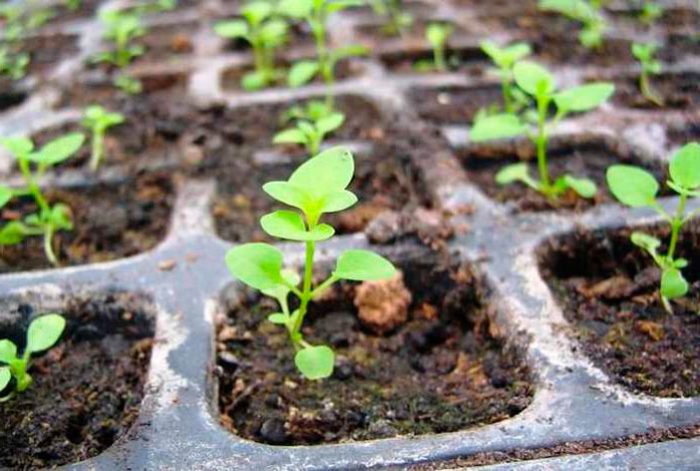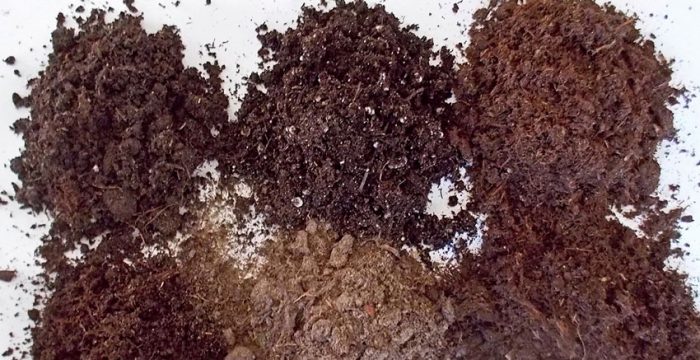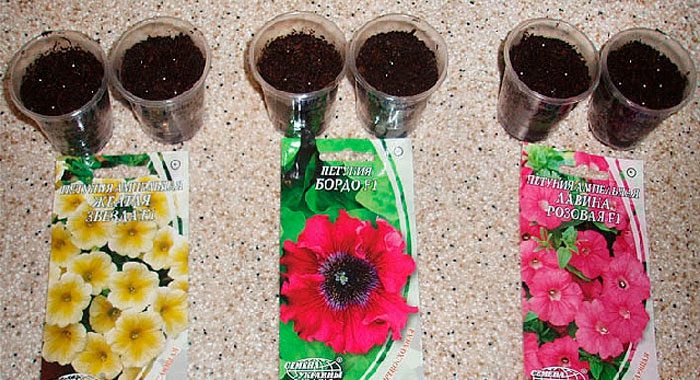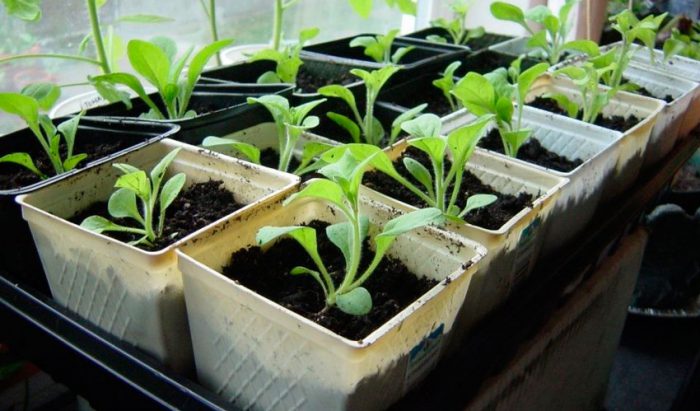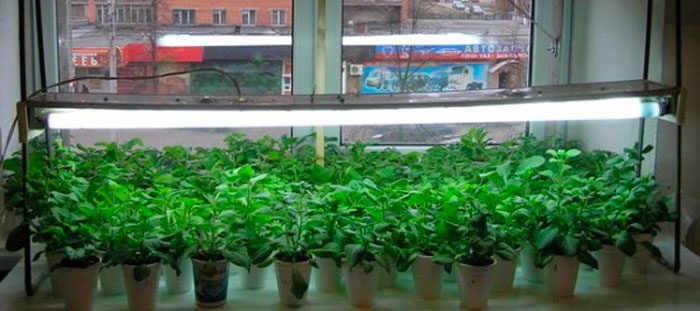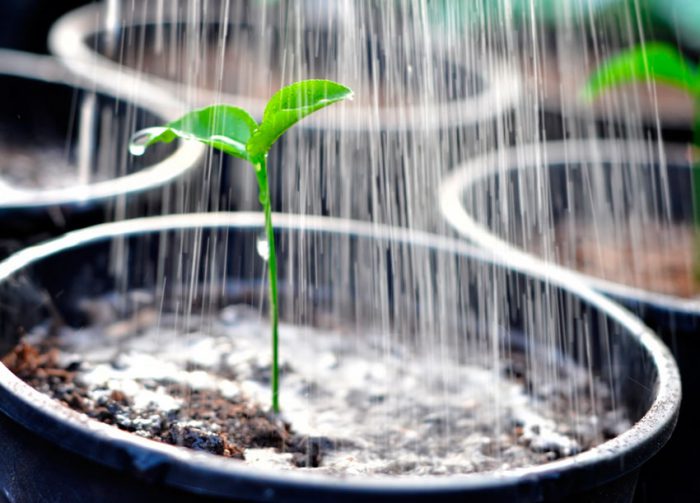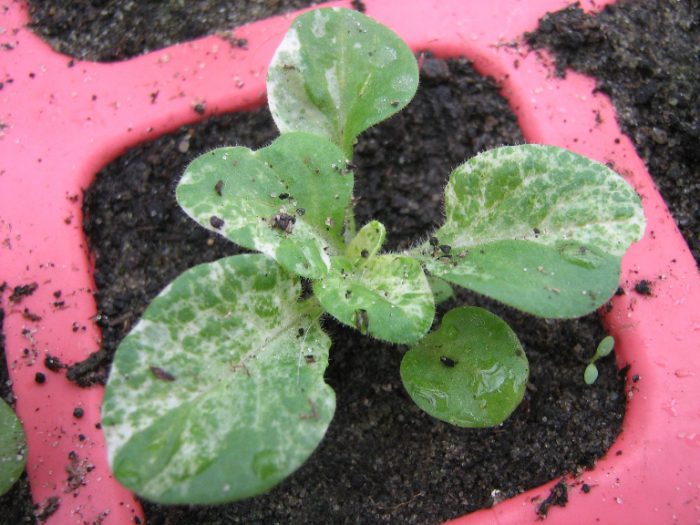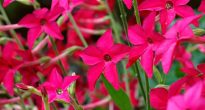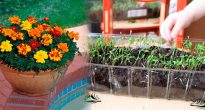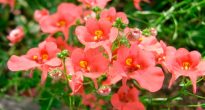Such incredibly beautiful flowers as petunias can become a wonderful decoration not only for the garden, but also at home, as well as terraces, balconies, etc. This plant is one of the longest and most lush-flowering plants, and it also has a variety of varieties, colors and shapes. Petunia is usually grown as an annual. However, there are some difficulties in growing petunia seedlings. So, in order for this event to be successful, it is necessary to sow such a plant at a certain time.
Content
How to grow petunia seedlings from seeds
Seedling mix suitable for seedlings
A slightly acidic or neutral soil mixture is suitable for growing seedlings. It should be loose, full of nutrients, able to retain water, but not get too wet. You can buy a similar earth mixture, or rather, the universal Stender soil, in a specialized store. However, you will need to add additives to this soil. So, for 5 liters of soil, a five hundred gram jar of wood ash, 250 grams of perlite, and another 1 large spoon of Kemira or potassium sulfate are taken. The soil mixture can be prepared with your own hands. To do this, it is necessary to combine humus, turf soil, sand, as well as well-decomposed peat, which must be taken in a ratio of 2: 2: 1: 2. You can prepare a suitable mixture of sand, garden soil and peat, which are taken in a 1: 1: 2 ratio. The finished soil mixture must be sieved 2 times with a sieve. So, the first time you need to use a coarse sieve, and the second time - a finer sieve. Then the ground must be watered with a solution of Previkur (cook according to the instructions) or manganese potassium (strong).
Sowing petunias for seedlings
Seeds should be purchased only those that are made by a trusted manufacturer, otherwise you will have to wait for seedlings for a long time if they appear at all. If you use pelleted seeds for planting, then somehow you should not particularly prepare them for planting. But it is worth remembering that in dry soil they grow extremely poorly, since the layer covering them cannot dissolve.When buying simple seeds, you need to ask the seller how to store them correctly and for how long it is possible. It is recommended to use fresh seeds for planting, since it is the low germination rate that is the main difficulty in growing such plants.
For planting, it is recommended to use a box made of wood or plastic, the height of which should be about 10 centimeters. In this case, special holes for drainage must be made at the bottom of the container. Treat the bottom of the box with a potassium manganese solution, and then rinse it with clean water. Lay a layer of small expanded clay on the bottom, and on top of it pour the prepared earth mixture. In this case, it is necessary that the earth does not reach the upper edge of the container by 2 centimeters. These seeds do best when sown on snow, so if there is snow outside, place it on top of the soil and compact slightly. The seeds are sown directly into the snow. Then the box is covered with glass or foil. After the snow layer has melted, the seeds will be sucked into the substrate. In the absence of snow, sowing is carried out on the surface of a wet substrate, and then the seeds are sprayed on top with a fine spray gun. After that, the box also needs to be covered with glass or film. Seeds should not be buried in the soil or sprinkled with even a thin layer of earth, because they germinate only in the presence of light. For more even sowing, it is recommended to mix small seeds with a small amount of dry sand. Place the container in a well-lit and warm (about 25 degrees) place.
Growing seedlings in tablets
If you purchased pelleted seeds, then it is best to use special peat tablets for sowing them. Medium-sized tablets (3.5 or 4.5 centimeters in diameter) are suitable for this purpose. First, a peat tablet must be immersed in water so that it becomes soaked. After that, the excess liquid is removed, and the prepared tablets must be placed in a tray with high edges. Then, using a toothpick or an ordinary match, 1 seed is placed in each tablet. Then watering is carried out with a pipette, which will allow the layer of substance covering the seed to be soaked. After a few minutes, use your fingers to smear the shells, which should be limp by that time. This will allow the seeds to germinate faster. Then the container on top should be covered with a film or glass and placed in a well-lit, warm (about 25 degrees) place.
This method of growing helps to increase the germination of petunias. And also flower growers note that it is much easier to care for such seedlings, because they do not need to be planted, and you can also easily understand when the plant needs watering.
Growing petunia seedlings in cassettes
Growing in cassettes, according to most growers, is a very convenient, as well as relatively economical, way. Thus, a cassette with cells is designed for repeated use, and the plants planted in it do not need further picking. If desired, you can purchase cassettes with different numbers of cells. However, it should be taken into account that the more cells are in the cassette, the smaller they are. For sowing petunias, experts advise those cassettes whose cells are of a sufficiently large size, while their height should not be less than 10 centimeters. The cells can be filled with the soil mixture mentioned above, but peat tablets are also placed in them if desired. You need to care for such seedlings in the same way as for those grown in simple boxes.
Should you buy ready-made seedlings?
The question of buying ready-made petunia seedlings is of particular concern to inexperienced flower growers, since not every one of them is able to grow it on their own. If you want to grow petunia yourself, you just need to buy high-quality seeds and adhere to the above sowing rules.However, if the florist does not know at all how to grow seedlings and this scares him, then it is quite possible to purchase ready-made petunia seedlings, only this must be done in such a flower shop that inspires confidence. By the way, in spring it is very easy to do this, since this seedling is not a deficit.
However, before you go for petunia seedlings, you need to remember a few rules that will help you choose high-quality and healthy plants:
- the substrate in which the petunia grows should in no case be wet;
- seedlings with dried tops and yellowish leaves are most likely sick with chlorosis and the plants are already dying of the root system;
- do not take an overgrown petunia, since these plants in open soil can either begin to stretch out, or stop growing altogether (depending on how badly the roots have suffered);
- inspect the seamy side of the foliage, as there may be pests.
Petunia seedling care
Optimal growing conditions
Best of all, the seeds of these flowers germinate at a temperature of 24 or 25 degrees. Hybrids are especially demanding on temperature. So, if it is colder, then they will not sprout, and in warmer conditions, the plants begin to hurt, and their stems become elongated. In the event that the necessary temperature and good lighting are provided, the first shoots can be seen already 5-7 days after sowing. When this happens, the seedlings will need to be ventilated a couple of times a day. To do this, you need to remove the shelter, while removing water droplets from it. The first time you need to open for 20 minutes, then for 40 minutes, etc. At the same time, you need to lower the air temperature. So, during the day it should be about 20 degrees, and at night - up to 16 degrees. At first, the plants are characterized by extremely slow growth. The fact is that at this time their roots are actively growing and developing. It should also be remembered that seedlings in the last days of February and in the month of March require illumination. In cases where the petunias sprout very thickly, thinning will be required, which can be done with tweezers.
The cover is removed for good only after the plants begin to touch it. However, it is important at this time to maintain the moisture content of the substrate at the same level.
Illumination of petunia seedlings
In order for newly emerged petunias to develop and grow normally, they need almost round-the-clock lighting. If the plants are provided with good lighting, then this will accelerate their growth, as well as significantly bring the beginning of flowering closer. Then such flowers must be provided with daylight hours, the duration of which should be equal to 11-12 hours. In this case, the maximum illumination should be equal to 50 thousand lux. To do this, additional lighting must be switched on early in the morning (7-8 hours), and switched off late in the evening (21-22 hours). When the pick is made, the illumination level should be slightly increased to 55 thousand lux.
For illumination, LED, fluorescent, gas-discharge lamps, as well as special phytolamps are suitable. They must be installed above the seedlings at a height of about 20 centimeters.
How to water properly
Proper watering is very important for petunia seedlings. The fact is that such a plant needs moderate moisture. So, if the soil is too damp, then this will lead to the appearance of rot and fungal diseases, and overdrying the substrate can be fatal for young plants. Drip irrigation is recommended for such seedlings. So, using a syringe, water must be dripped directly under the root of the plant, while trying to ensure that the liquid does not fall on the surface of the foliage in any case. You can also pour liquid along the side of the container while watering. You can also water such a plant through a tray.
Only soft and well-settled water should be used for irrigation (it should not contain chlorine).You can use either lukewarm water or room temperature. A couple of minutes before watering, a little freshly squeezed lemon juice should be poured into a container of water.
If the day is sunny, then watering must be arranged in the evening. And if the sky is clouded with clouds, then you need to water the plant in the morning.
Fertilizer
Young plants need a lot of nutrients, so they need to systematically fertilize the substrate. In the first 14 days after the emergence of shoots, it is necessary to spray the petunia with a weak solution of potassium manganese or Pervikur as the upper layer of the substrate dries out. When 3 and 4 real leaves begin to grow in the plants, then a solution of yellow Kristalon must be added to the ground (for 5 liters of water ½ part of a large spoon). Top dressing is carried out both on foliage (especially if there are a large number of seedlings), and directly into the soil. Fertilizers such as Uniflora micro or Kristalon are excellent for leaf feeding. The grown seedlings need to be fed 3 times every 7 days, while it is recommended to use the foliar and root methods alternately.
After a couple of weeks, as the pick will be made, the plant should be sprayed with a solution of a product that stimulates root growth. For this purpose, it is recommended to use a remedy such as: Solution, Plantafol, Kemira lux, as well as Aquarin. In this case, the solution should be prepared exactly following the attached instructions.
It should be taken into account that in the case when an earth mixture enriched with nutrients was used for sowing, then it will be possible to do without additional fertilizing. However, when using poor soil, they are required.
Picking seedlings of petunia
In the event that the seedlings were sown in a common box, they will need a pick as they grow. And that's all because such a petunia is grown in the house for 8-12 weeks, and at the same time the plants have developed and sufficiently voluminous roots. For picking, it is recommended to use containers (cups), the volume of which is 200–250 mg, while at the bottom they must have drainage holes. You need to dive the petunia after it has 2-3 pairs of true leaves. The plant is captured together with the earthen lump, trying not to disturb the roots, and transferred into an individual container. Then so much earth mixture is poured so that no voids remain in the glass. The transplanted plants are watered. After the soil has settled, the earth is poured into the container. In order to avoid pulling out the seedlings, 7 days after the pick, the temperature should be kept 3-4 degrees lower than usual. Also, seedlings must be protected at this time from direct sunlight. It happens that the plant has to dive 2 times.
When grown in tablets, if necessary, the plant can be planted in an individual container right with it.
The first feeding after a pick is recommended to be carried out no earlier than 1–1.5 weeks after it.
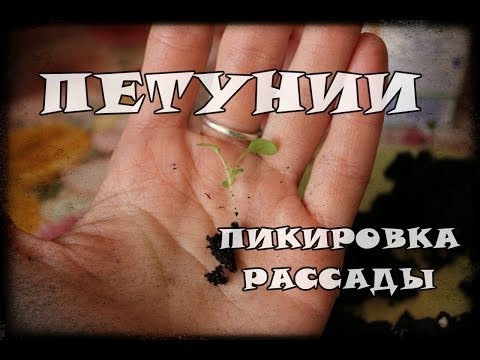

Watch this video on YouTube
Pinching petunia seedlings
For better branching of the petunia, you need a pinch. Strongly growing and hybrid varieties are pinched over 4 or 5 leaves, while breaking out the upper part of the stem along with the growing point. As a result, a young shoot will appear from each leaf sinus, and such a plant will bloom more abundantly. After half a month, the 2nd pinch is carried out, while it should be borne in mind that in order to obtain a very lush bush, it is necessary to perform this procedure several times.
Seedlings of ampelous varieties are not pinched, because this will have little effect on its branching. Such a plant is weakly branching.
Diseases and pests
Most often, black leg disease develops, and excessive moisture can become the cause. At the very beginning, a dark spot appears at the base of the shoot, while the plant tissue becomes soft and rots.Then, a constriction is formed in this place, and the shoot lays down under its own weight. Diseased plants should be destroyed. The place where they grew is spilled with a strong solution of potassium manganese, Maxim or Formalin (40%).
Also, such a plant often suffers from chlorosis (lack of iron). This can be due to alkalization of the soil as a result of overflows. In this case, a special iron chelate must be added to the soil, which is part of the Ferovit product.
A spider mite can also settle on the leaves, which really likes high dryness. It sucks out plant juice, and can also become a carrier of a dangerous viral disease. To combat it, it is recommended to use acaricidal drugs, for example: Neoron, Aktellik, Fitoverm, etc.
Rules for preparing seedlings for transplanting into open soil
When the pick is left behind, the mature seedlings can be prepared for planting in open soil. Hardening is carried out throughout the crescent, while the plant should be taught to the street gradually. The first time the plants should be outside for 10 to 15 minutes, and then each day the duration of their stay should be increased. Immediately before planting, the seedlings should be outside around the clock. Petunia should be planted in the second half of May and the first - June.
For planting, you can select any area of the soil. However, petunia will grow best in a well-lit area with loamy, nutrient-rich soil. Remove weeds, debris from the soil and dig it up, it is recommended to add humus or compost.
Disembarkation is carried out in the evening at sunset or in cloudy weather. A hole of ten centimeters depth is made, while the distance between the plants directly depends on their variety. So, between the plants of ampelous varieties, a distance of about 28-30 centimeters is left, between small-flowered varieties - 18–20 centimeters, and between large-flowered varieties - 23–25 centimeters. Water the seedlings well, and then transfer them together with the soil into the holes.
Planted plants should be watered, and the surface of the soil should be sprinkled with mulch (humus or peat). The first day after disembarkation, petunia should be shaded from the direct rays of the sun using cardboard boxes or a special canopy.

